A Platform for Ultra-Fast Proton Probing of Matter in Extreme Conditions
Abstract
:1. Introduction
2. Design
2.1. Temporal Selection
2.2. Energy Selection
2.3. Transmission Coefficient
- The first collimator selects a quasi-pencil beam from the initial laser-driven protons. The proton source consists of a circular surface with a radius of a few hundred micrometers, which is significantly larger than the slit apertures, typically 10–20 m in diameter. Spatial selection can be achieved using either a single or double pinhole, depending on the spatial properties of the proton beam. If the proton beam propagates laminar (i.e., individual proton trajectories do not cross), a single pinhole is sufficient. Conversely, if the proton source is randomly distributed, a double-pinhole system is necessary.
- The second phase involves transporting the selected beam isochronally into the magnetic dipole. During this phase, the energy–time distribution is transformed into an energy–space distribution along the side of the dipole. For higher central energies, the path through the dipole is longer, resulting in a larger final band at the exit of the selector, as measured by the MCP detector.
- The third and final phase involves selecting the energy band out of the selector. This is carried out using a second movable pinhole along the side of the dipole where the proton energy is spatially distributed. The spatial distribution of the proton source along the side is explained by the equations from (8) to (10).
3. Numerical Simulations
3.1. Particle Tracking
3.2. Monte Carlo Simulations
4. Discussion and Conclusions
Author Contributions
Funding
Data Availability Statement
Acknowledgments
Conflicts of Interest
References
- Schaeffer, D.B.; Bott, A.F.A.; Borghesi, M.; Flippo, K.A.; Fox, W.; Fuchs, J.; Li, C.; Séguin, F.H.; Park, H.S.; Tzeferacos, P.; et al. Proton imaging of high-energy-density laboratory plasmas. Rev. Mod. Phys. 2023, 95, 045007. [Google Scholar] [CrossRef]
- Hurricane, O.; Springer, P.; Patel, P.; Callahan, D.; Baker, K.; Casey, D.; Divol, L.; Döppner, T.; Hinkel, D.E.; Hohenberger, M.; et al. Approaching a burning plasma on the NIF. Phys. Plasmas 2019, 26, 052704. [Google Scholar] [CrossRef]
- Zylstra, A.; Hurricane, O.; Callahan, D.A.; Kritcher, A.; Ralph, J.; Robey, H.; Ross, J.; Young, C.; Baker, K.; Casey, D.; et al. Burning plasma achieved in inertial fusion. Nature 2022, 601, 542–548. [Google Scholar] [CrossRef] [PubMed]
- Margarone, D.; Cirrone, G.A.P.; Cuttone, G.; Amico, A.; Andò, L.; Borghesi, M.; Bulanov, S.; Stepan, S.; Chatain, D.; Fajstavr, A.; et al. ELIMAIA: A Laser-Driven Ion Accelerator for Multidisciplinary Applications. Quantum Beam Sci. 2018, 2, 8. [Google Scholar] [CrossRef]
- Roth, M.; Cowan, T.E.; Key, M.; Hatchett, S.; Brown, C.; Fountain, W.; Johnson, J.; Pennington, D.; Snavely, R.; Wilks, S.; et al. Fast Ignition by Intense Laser-Accelerated Proton Beams. Phys. Rev. Lett. 2001, 86, 436–439. [Google Scholar] [CrossRef] [PubMed]
- Zylstra, A.B.; Frenje, J.; Grabowski, P.; Li, C.; Collins, G.; Fitzsimmons, P.; Glenzer, S.; Graziani, F.; Hansen, S.; Hu, S.; et al. Measurement of Charged-Particle Stopping in Warm Dense Plasma. Phys. Rev. Lett. 2015, 114, 215002. [Google Scholar] [CrossRef] [PubMed]
- Patel, P.K.; Mackinnon, A.J.; Key, M.H.; Cowan, T.E.; Foord, M.E.; Allen, M.; Price, D.; Ruhl, H.; Springer, P.; Stephens, R. Isochoric Heating of Solid-Density Matter with an Ultrafast Proton Beam. Phys. Rev. Lett. 2003, 91, 125004. [Google Scholar] [CrossRef] [PubMed]
- Borghesi, M.; Campbell, D.; Schiavi, A.; Haines, M.; Willi, O.; MacKinnon, A.; Patel, P.; Gizzi, L.; Galimberti, M.; Clarke, R.; et al. Electric field detection in laser-plasma interaction experiments via the proton imaging technique. Phys. Plasmas 2002, 9, 2214–2220. [Google Scholar] [CrossRef]
- Borghesi, M.; Romagnani, L.; Schiavi, A.; Campbell, D.; Haines, M.; Willi, O.; Mackinnon, A.; Galimberti, M.; Gizzi, L.; Clarke, R.; et al. Measurement of highly transient electrical charging following high-intensity laser–solid interaction. Appl. Phys. Lett. 2003, 82, 1529–1531. [Google Scholar] [CrossRef]
- Borghesi, M.; Mackinnon, A.; Campbell, D.H.; Hicks, D.; Kar, S.; Patel, P.K.; Price, D.; Romagnani, L.; Schiavi, A.; Willi, O. Multi-MeV proton source investigations in ultraintense laser-foil interactions. Phys. Rev. Lett. 2004, 92, 055003. [Google Scholar] [CrossRef]
- Mackinnon, A.J.; Patel, P.K.; Borghesi, M.; Clarke, R.C.; Freeman, R.R.; Habara, H.; Hatchett, S.P.; Hey, D.; Hicks, D.G.; Kar, S.; et al. Proton Radiography of a Laser-Driven Implosion. Phys. Rev. Lett. 2006, 97, 045001. [Google Scholar] [CrossRef] [PubMed]
- Volpe, L.; Batani, D.; Vauzour, B.; Nicolai, P.; Santos, J.; Regan, C.; Morace, A.; Dorchies, F.; Fourment, C.; Hulin, S.; et al. Proton radiography of laser-driven imploding target in cylindrical geometry. Phys. Plasmas 2011, 18, 012704. [Google Scholar] [CrossRef]
- Malko, S.; Cayzac, W.; Ospina-Bohorquez, V.; Bhutwala, K.; Bailly-Grandvaux, M.; McGuffey, C.; Fedosejevs, R.; Vaisseau, X.; Tauschwitz, A.; Apiñaniz, J.; et al. Proton stopping measurements at low velocity in warm dense carbon. Nat. Commun. 2022, 13, 2893. [Google Scholar] [CrossRef]
- Zastrau, U.; Appel, K.; Baehtz, C.; Baehr, O.; Batchelor, L.; Berghäuser, A.; Banjafar, M.; Brambrink, E.; Cerantola, V.; Cowan, T.; et al. The High Energy Density Scientific Instrument at the European XFEL. J. Synchrotron Radiat. 2021, 28, 1393–1416. [Google Scholar] [CrossRef] [PubMed]
- Volpe, L.; Fedosejevs, R.; Gatti, G.; Pérez-Hernández, J.; Méndez, C.; Apiñaniz, J.; Vaisseau, X.; Salgado, C.; Huault, M.; Malko, S.; et al. Generation of high energy laser-driven electron and proton sources with the 200 TW system VEGA 2 at the Centro de Laseres Pulsados. High Power Laser Sci. Eng. 2019, 7, e25. [Google Scholar] [CrossRef]
- Wilks, S.; Langdon, A.; Cowan, T.; Roth, M.; Singh, M.; Hatchett, S.; Key, M.; Pennington, D.; MacKinnon, A.; Snavely, R. Energetic proton generation in ultra-intense laser-solid interactions. Physics of Plasmas 2001, 8, 542–549. [Google Scholar] [CrossRef]
- Macchi, A.; Borghesi, M.; Passoni, M. Ion acceleration by superintense laser-plasma interaction. Rev. Mod. Phys. 2013, 85, 751–793. [Google Scholar] [CrossRef]
- Dromey, B.; Coughlan, M.; Senje, L.; Taylor, M.; Kuschel, S.; Villagomez-Bernabe, B.; Stefanuik, R.; Nersisyan, G.; Stella, L.; Kohanoff, J.; et al. Picosecond metrology of laser-driven proton bursts. Nat. Commun. 2016, 7, 10642. [Google Scholar] [CrossRef] [PubMed]
- Albert, F.; Couprie, M.; Debus, A.; Downer, M.; Faure, J.; Flacco, A.; Gizzi, L.; Grismayer, T.; Huebl, A.; Joshi, C.; et al. 2020 roadmap on plasma accelerators. New J. Phys. 2021, 23, 031101. [Google Scholar] [CrossRef]
- Kar, S.; Ahmed, H.; Prasad, R.; Cerchez, M.; Brauckmann, S.; Aurand, B.; Cantono, G.; Hadjisolomou, P.; Lewis, C.L.; Macchi, A.; et al. Guided post-acceleration of laser-driven ions by a miniature modular structure. Nat. Commun. 2016, 7, 10792. [Google Scholar] [CrossRef]
- Ahmed, H.; Kar, S.; Cantono, G.; Hadjisolomou, P.; Poye, A.; Gwynne, D.; Lewis, C.; Macchi, A.; Naughton, K.; Nersisyan, G.; et al. Efficient post-acceleration of protons in helical coil targets driven by sub-ps laser pulses. Sci. Rep. 2017, 7, 10891. [Google Scholar] [CrossRef] [PubMed]
- Hadjisolomou, P.; Ahmed, H.; Prasad, R.; Cerchez, M.; Brauckmann, S.; Aurand, B.; Schroer, A.; Swantusch, M.; Willi, O.; Borghesi, M.; et al. Dynamics of guided post-acceleration of protons in a laser-driven travelling-field accelerator. Plasma Phys. Control. Fusion 2020, 62, 115023. [Google Scholar] [CrossRef]
- Ahmed, H.; Hadjisolomou, P.; Naughton, K.; Alejo, A.; Brauckmann, S.; Cantono, G.; Ferguson, S.; Cerchez, M.; Doria, D.; Green, J.; et al. High energy implementation of coil-target scheme for guided re-acceleration of laser-driven protons. Sci. Rep. 2021, 11, 699. [Google Scholar] [CrossRef] [PubMed]
- Burza, M.; Gonoskov, A.; Genoud, G.; Persson, A.; Svensson, K.; Quinn, M.; McKenna, P.; Marklund, M.; Wahlström, C.G. Hollow microspheres as targets for staged laser-driven proton acceleration. New J. Phys. 2011, 13, 013030. [Google Scholar] [CrossRef]
- Toncian, T.; Borghesi, M.; Fuchs, J.; d’Humières, E.; Antici, P.; Audebert, P.; Brambrink, E.; Cecchetti, C.A.; Pipahl, A.; Romagnani, L.; et al. Ultrafast laser-driven microlens to focus and energy-select mega-electron volt protons. Science 2006, 312, 410–413. [Google Scholar] [CrossRef]
- Kar, S.; Markey, K.; Simpson, P.; Bellei, C.; Green, J.; Nagel, S.; Kneip, S.; Carroll, D.; Dromey, B.; Willingale, L.; et al. Dynamic control of laser-produced proton beams. Phys. Rev. Lett. 2008, 100, 105004. [Google Scholar] [CrossRef]
- Schollmeier, M.; Becker, S.; Geißel, M.; Flippo, K.; Blažević, A.; Gaillard, S.; Gautier, D.; Grüner, F.; Harres, K.; Kimmel, M.; et al. Controlled Transport and Focusing of Laser-Accelerated Protons<? format?> with Miniature Magnetic Devices. Phys. Rev. Lett. 2008, 101, 055004. [Google Scholar]
- Ahmed, H.; Kar, S.; Cantono, G.; Nersisyan, G.; Brauckmann, S.; Doria, D.; Gwynne, D.; Macchi, A.; Naughton, K.; Willi, O.; et al. Investigations of ultrafast charge dynamics in laser-irradiated targets by a self probing technique employing laser driven protons. Nucl. Instrum. Methods Phys. Res. A 2016, 829, 172–175. [Google Scholar] [CrossRef]
- Busold, S.; Schumacher, D.; Deppert, O.; Brabetz, C.; Frydrych, S.; Kroll, F.; Joost, M.; Al-Omari, H.; Blažević, A.; Zielbauer, B.; et al. Focusing and transport of high-intensity multi-MeV proton bunches from compact laser-driven source. Phys. Rev. Spec. Top.—Accel. Beams 2013, 16, 101302. [Google Scholar] [CrossRef]
- Cirrone, G.A.P.; Petringa, G.; Catalano, R.; Schillaci, F.; Allegra, L.; Amato, A.; Avolio, R.; Costa, M.; Cuttone, G.; Fajstavr, A.; et al. ELIMED-ELIMAIA: The First Open User Irradiation Beamline for Laser-Plasma-Accelerated Ion Beams. Front. Phys. 2020, 8, 564907. [Google Scholar] [CrossRef]
- Kroll, F.; Brack, F.; Bernert, C.; Bock, S.; Bodenstein, E.; Brüchner, K.; Cowan, T.; Gaus, L.; Gebhardt, R.; Helbig, U.; et al. Tumour irradiation in mice with a laser-accelerated proton beam. Nat. Phys. 2022, 18, 316–322. [Google Scholar] [CrossRef]
- Chen, S.; Gauthier, M.; Higginson, D.; Dorard, S.; Mangia, F.; Riquier, R.; Atzeni, S.; Marquès, J.; Fuchs, J. Monochromatic short pulse laser produced ion beam using a compact passive magnetic device. Rev. Sci. Instrum. 2014, 85, 043504. [Google Scholar] [CrossRef] [PubMed]
- Teng, J.; Gu, Y.; Chen, J.; Zhu, B.; Zhang, B.; Zhang, T.; Tan, F.; Hong, W.; Zhang, B.; Wang, X. Magnetic quadrupoles lens for hot spot proton imaging in inertial confinement fusion. Nucl. Instrum. Methods Phys. Res. Sect. A Accel. Spectrometers Detect. Assoc. Equip. 2016, 826, 15–20. [Google Scholar] [CrossRef]
- Fernández, J.; Albright, B.; Beg, F.; Foord, M.; Hegelich, B.; Honrubia, J.; Roth, M.; Stephens, R.; Yin, L. Fast ignition with laser-driven proton and ion beams. Nucl. Fusion 2014, 54, 054006. [Google Scholar] [CrossRef]
- Kim, J.; Qiao, B.; McGuffey, C.; Wei, M.S.; Grabowski, P.E.; Beg, F.N. Self-Consistent Simulation of Transport and Energy Deposition of Intense Laser-Accelerated Proton Beams in Solid-Density Matter. Phys. Rev. Lett. 2015, 115, 054801. [Google Scholar] [CrossRef] [PubMed]
- McGuffey, C.; Kim, J.; Wei, M.S.; Nilson, P.M.; Chen, S.N.; Fuchs, J.; Fitzsimmons, P.; Foord, M.E.; Mariscal, D.; McLean, H.S.; et al. Focussing Protons from a Kilojoule Laser for Intense Beam Heating using Proximal Target Structures. Sci. Rep. 2020, 10, 9415. [Google Scholar] [CrossRef] [PubMed]
- Mančić, A.; Lévy, A.; Harmand, M.; Nakatsutsumi, M.; Antici, P.; Audebert, P.; Combis, P.; Fourmaux, S.; Mazevet, S.; Peyrusse, O.; et al. Picosecond Short-Range Disordering in Isochorically Heated Aluminum at Solid Density. Phys. Rev. Lett. 2010, 104, 035002. [Google Scholar] [CrossRef] [PubMed]
- Ping, Y.; Whitley, H.; McKelvey, A.; Kemp, G.; Sterne, P.; Shepherd, R.; Marinak, M.; Hua, R.; Beg, F.; Eggert, J. Heat-release equation of state and thermal conductivity of warm dense carbon by proton differential heating. Phys. Rev. E 2019, 100, 043204. [Google Scholar] [CrossRef] [PubMed]
- Grabowski, P.; Hansen, S.; Murillo, M.; Stanton, L.; Graziani, F.; Zylstra, A.; Baalrud, S.; Arnault, P.; Baczewski, A.; Benedict, L.; et al. Review of the first charged-particle transport coefficient comparison workshop. High Energy Density Phys. 2020, 37, 100905. [Google Scholar] [CrossRef]
- McKelvey, A.; Kemp, G.; Sterne, P.; Fernandez, A.; Shepherd, R.; Marinak, M.; Link, A.; Collins, G.; Sio, H.; King, J.; et al. Thermal conductivity measurements of proton-heated warm dense aluminum. Nat. Commun. 2017, 7, 7015. [Google Scholar] [CrossRef]
- White, T.; Vorberger, J.; Brown, C.; Crowley, B.; Davis, P.; Glenzer, S.; Harris, J.; Hochhaus, D.C.; Le Pape, S.; Ma, T.; et al. Observation of inhibited electron-ion coupling in strongly heated graphite. Sci. Rep. 2012, 2, 889. [Google Scholar] [CrossRef]
- Apiñaniz, J.; Malko, S.; Fedosejevs, R.; Cayzac, W.; Vaisseau, X.; de Luis, D.; Gatti, G.; McGuffey, C.; Bailly-Grandvaux, M.; Bhutwala, K.; et al. A quasi-monoenergetic short time duration compact proton source for probing high energy density states of matter. Sci. Rep. 2020, 11, 6881. [Google Scholar] [CrossRef]
- Meeker, D.C. Finite Element Method Magnetics, Version 4.2. 28 Feb 2018 Build. 2006. Available online: http://www.femm.info/wiki/HomePage (accessed on 7 July 2024).
- Bull, J. Magnetic Field Tracking Features in MCNP6; Technical Report, LA-UR-11-00872; Los Alamos National Laboratory: Los Alamos, NM, USA, 2011. [Google Scholar]
- Swift, A.; McKigney, E.; Schirato, R.; Robinson, A.; Temple, B. A Verification of MCNP6 FMESH Tally Capabilities; Technical Report; Los Alamos National Lab. (LANL): Los Alamos, NM, USA, 2015. [Google Scholar]

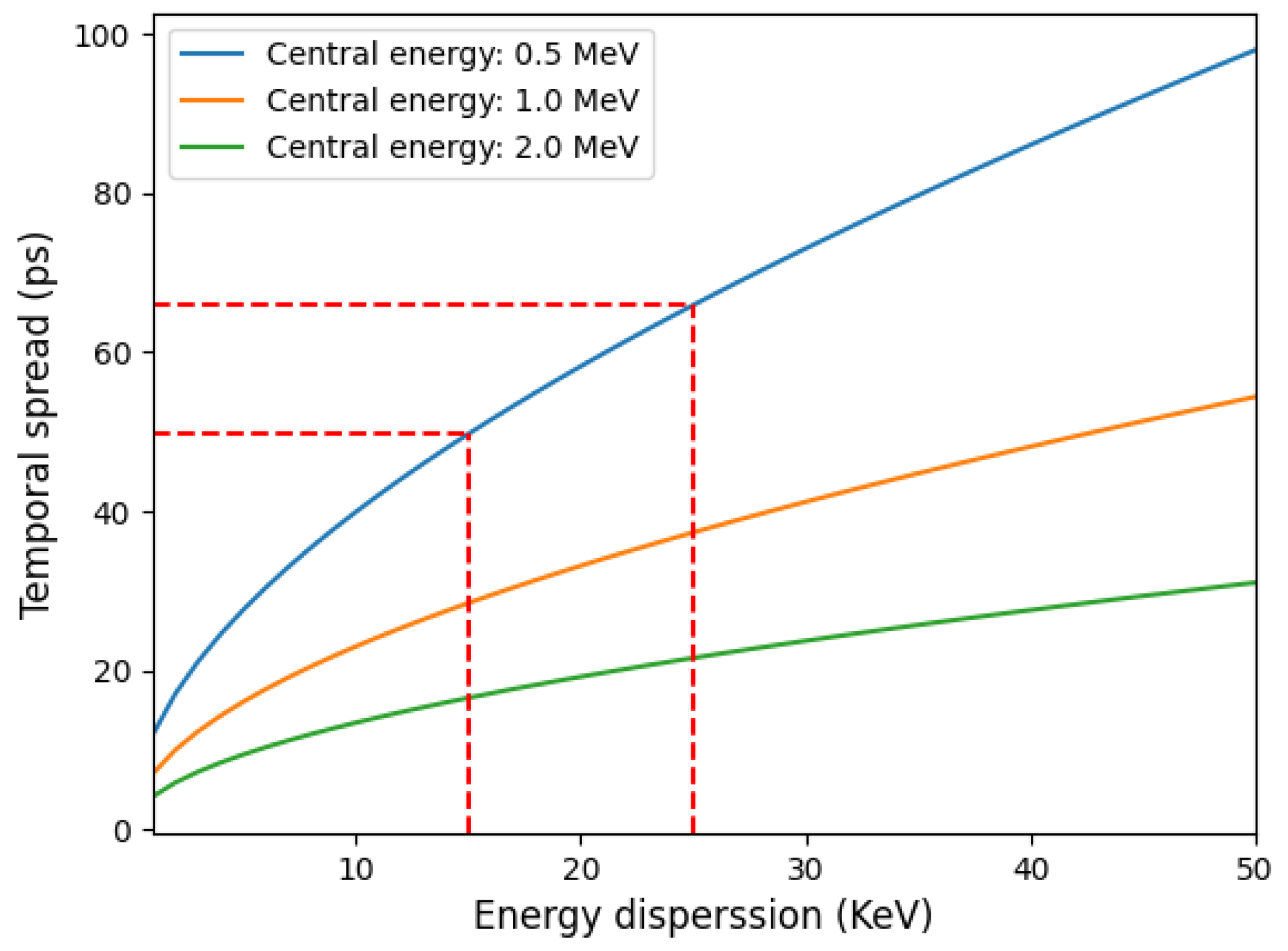
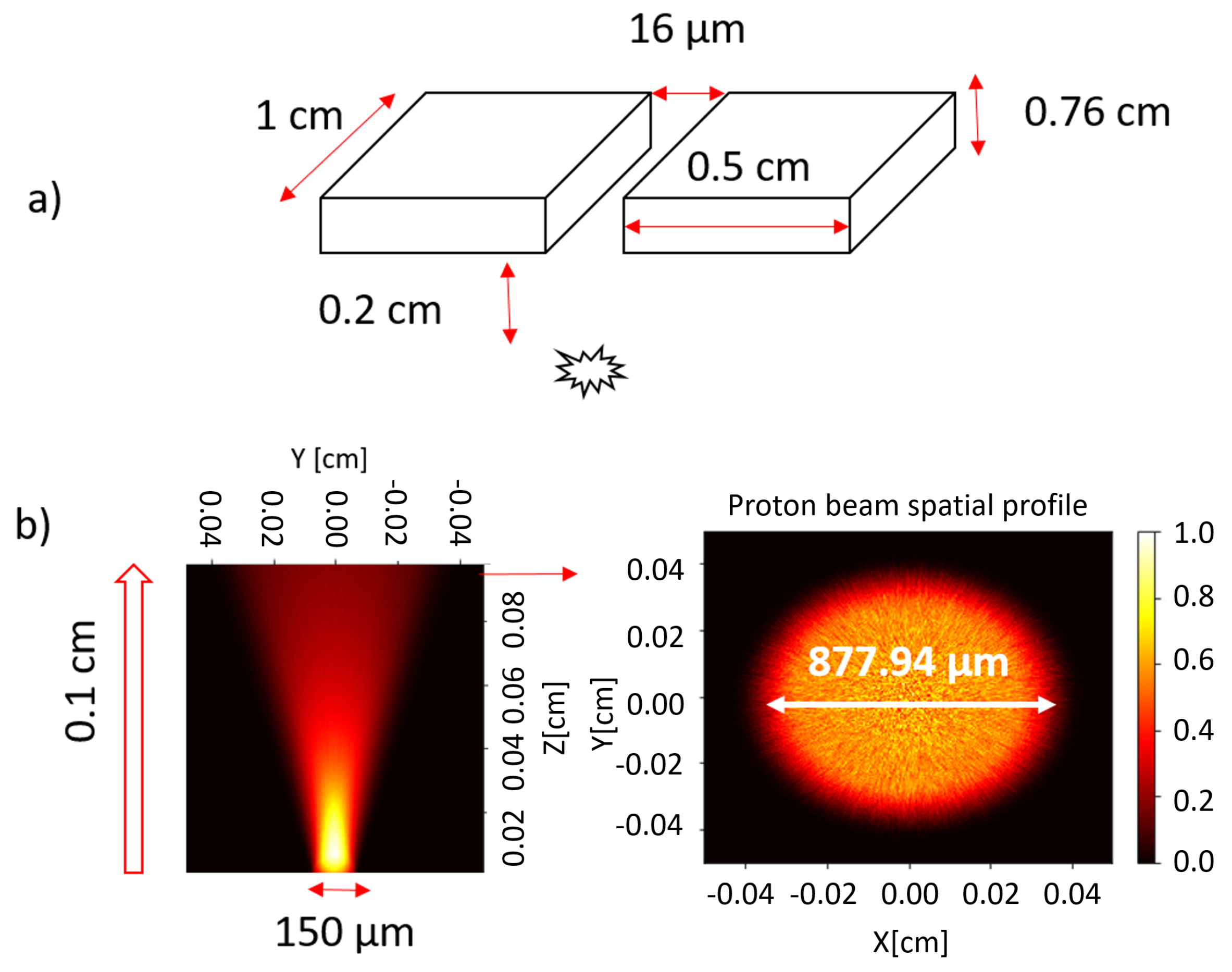
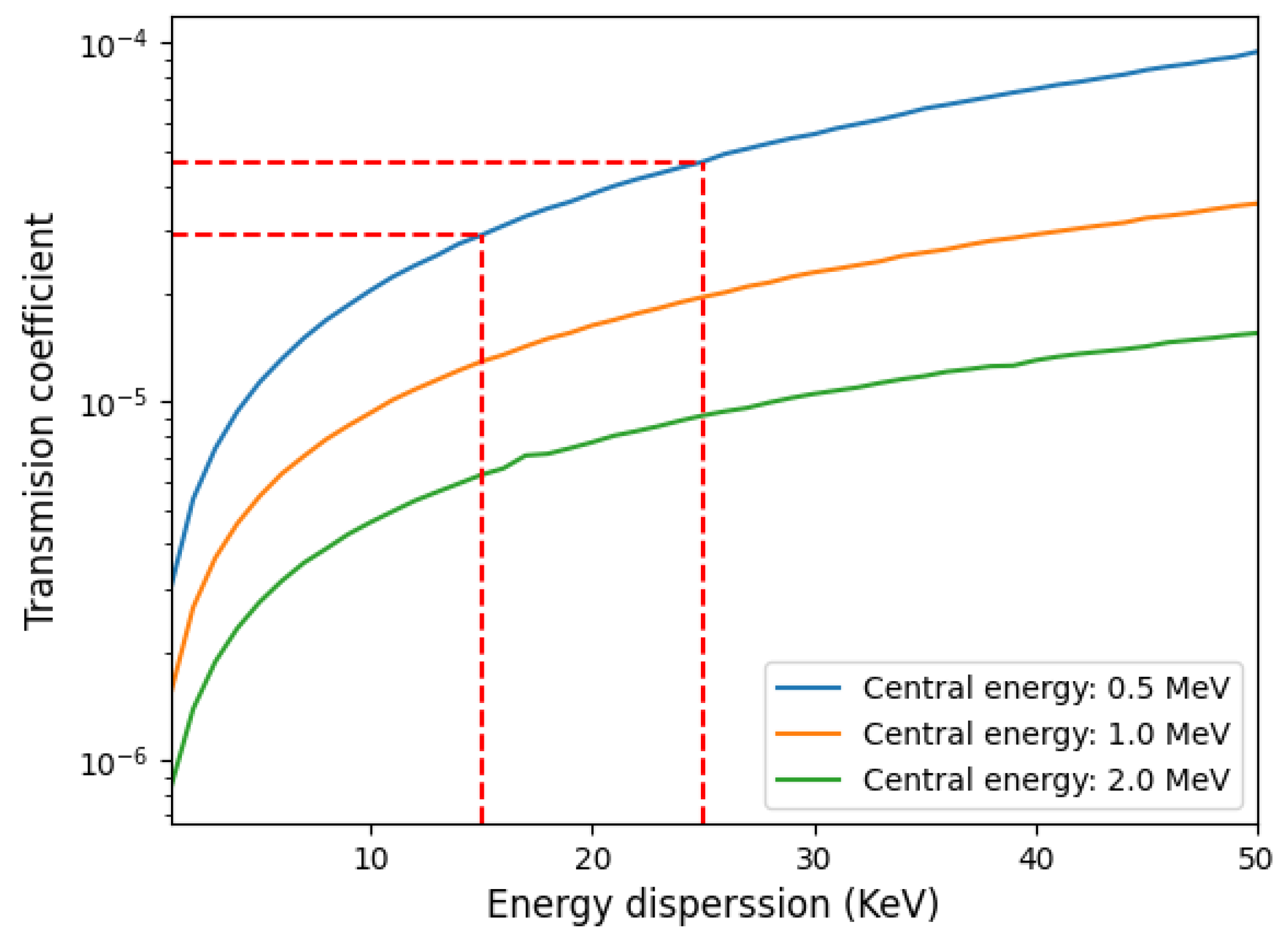
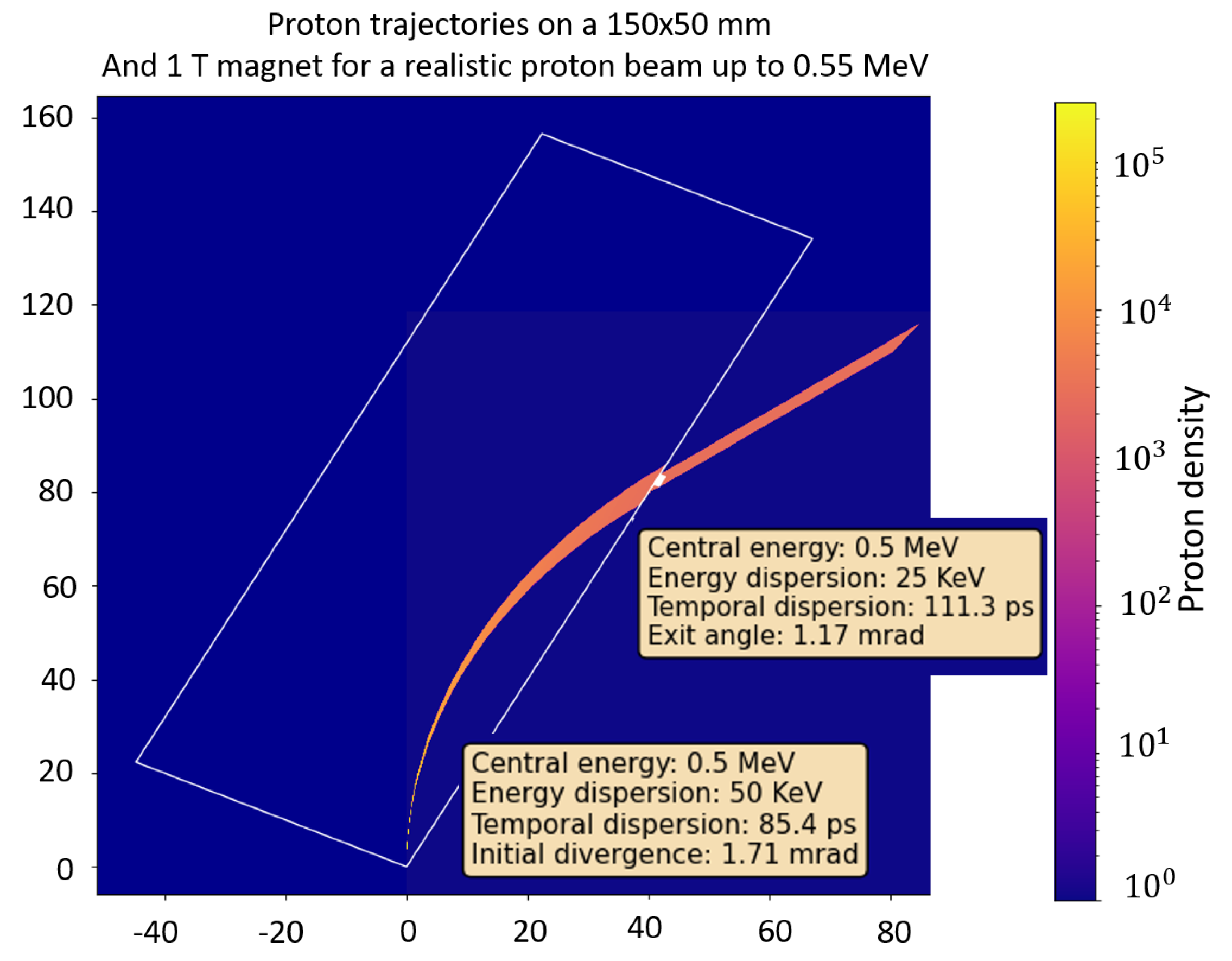
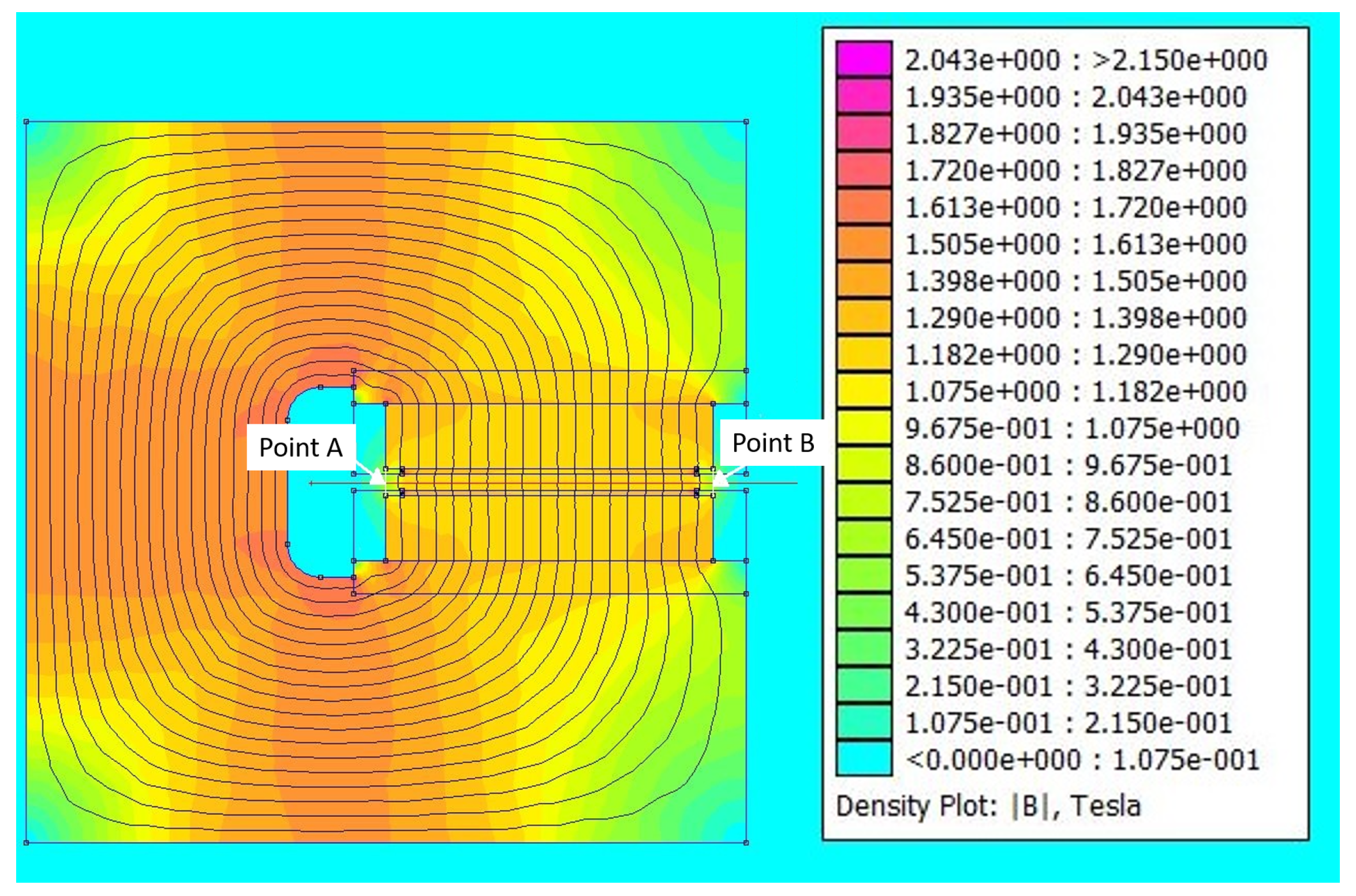


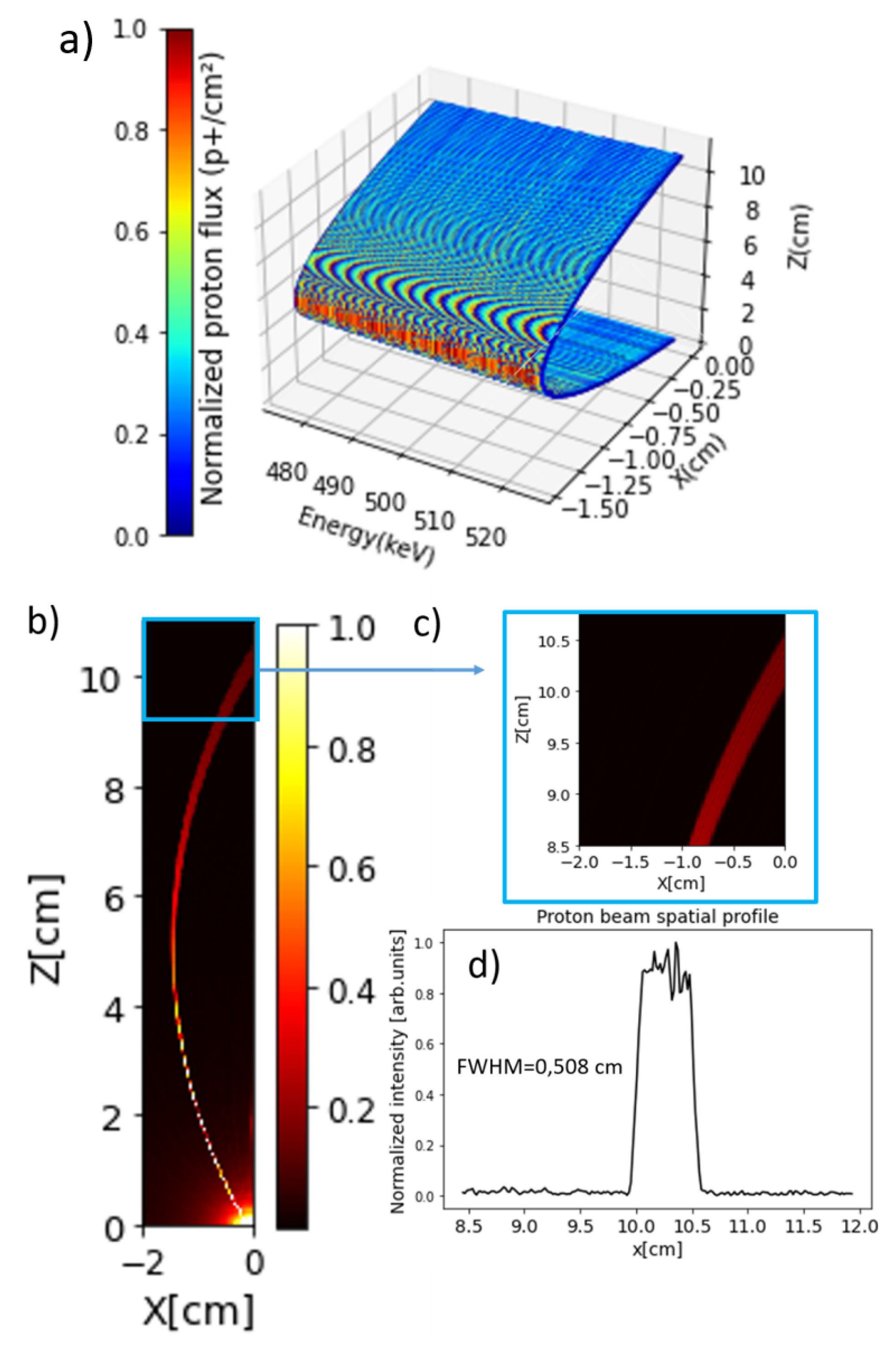
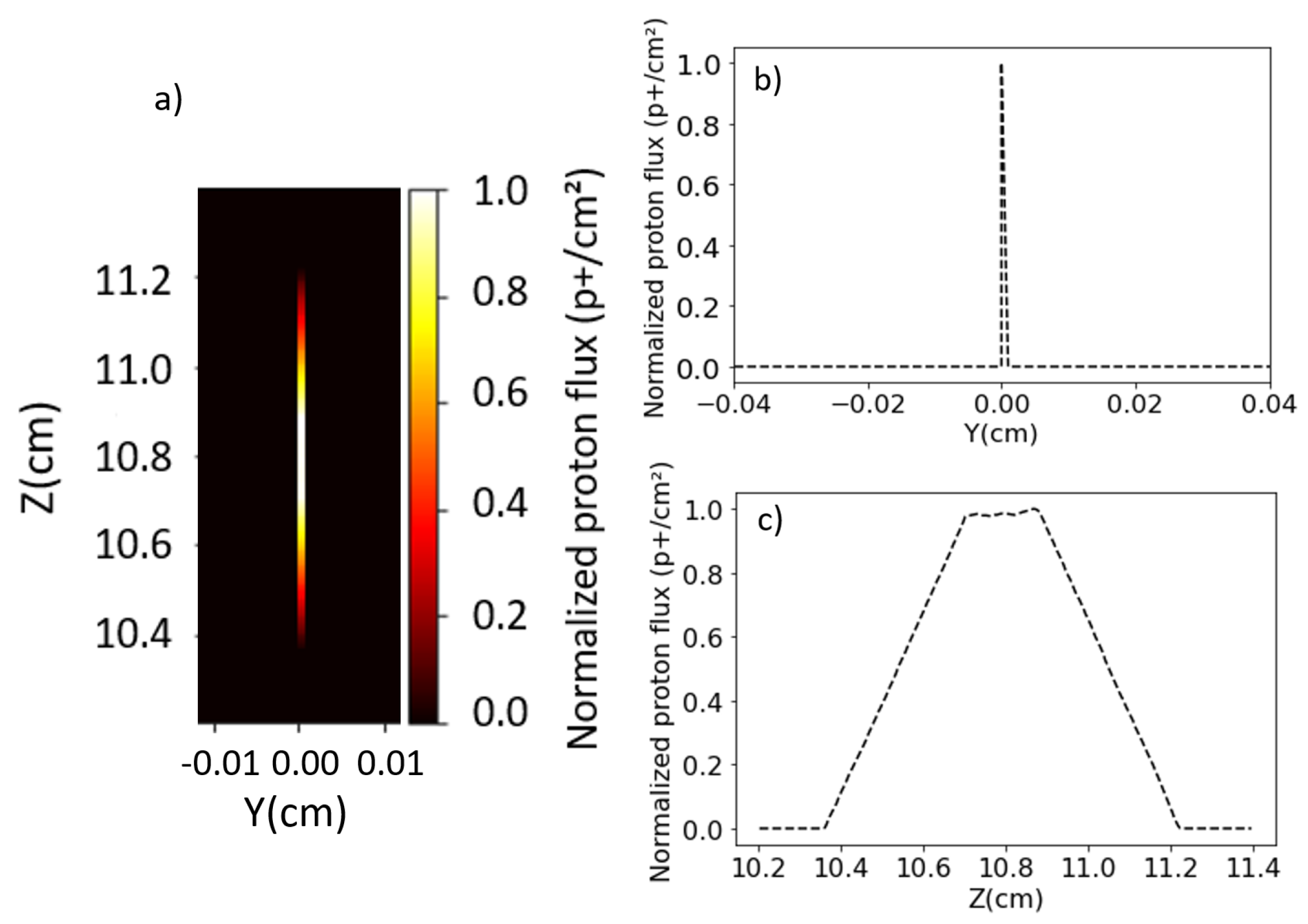
Disclaimer/Publisher’s Note: The statements, opinions and data contained in all publications are solely those of the individual author(s) and contributor(s) and not of MDPI and/or the editor(s). MDPI and/or the editor(s) disclaim responsibility for any injury to people or property resulting from any ideas, methods, instructions or products referred to in the content. |
© 2024 by the authors. Licensee MDPI, Basel, Switzerland. This article is an open access article distributed under the terms and conditions of the Creative Commons Attribution (CC BY) license (https://creativecommons.org/licenses/by/4.0/).
Share and Cite
Volpe, L.; Cebriano Ramírez, T.; Sánchez, C.S.; Perez, A.; Curcio, A.; De Luis, D.; Gatti, G.; Kebladj, B.; Khetari, S.; Malko, S.; et al. A Platform for Ultra-Fast Proton Probing of Matter in Extreme Conditions. Sensors 2024, 24, 5254. https://doi.org/10.3390/s24165254
Volpe L, Cebriano Ramírez T, Sánchez CS, Perez A, Curcio A, De Luis D, Gatti G, Kebladj B, Khetari S, Malko S, et al. A Platform for Ultra-Fast Proton Probing of Matter in Extreme Conditions. Sensors. 2024; 24(16):5254. https://doi.org/10.3390/s24165254
Chicago/Turabian StyleVolpe, Luca, Teresa Cebriano Ramírez, Carlos Sánchez Sánchez, Alberto Perez, Alessandro Curcio, Diego De Luis, Giancarlo Gatti, Berkhahoum Kebladj, Samia Khetari, Sophia Malko, and et al. 2024. "A Platform for Ultra-Fast Proton Probing of Matter in Extreme Conditions" Sensors 24, no. 16: 5254. https://doi.org/10.3390/s24165254
APA StyleVolpe, L., Cebriano Ramírez, T., Sánchez, C. S., Perez, A., Curcio, A., De Luis, D., Gatti, G., Kebladj, B., Khetari, S., Malko, S., Perez-Hernandez, J. A., & Frias, M. D. R. (2024). A Platform for Ultra-Fast Proton Probing of Matter in Extreme Conditions. Sensors, 24(16), 5254. https://doi.org/10.3390/s24165254





